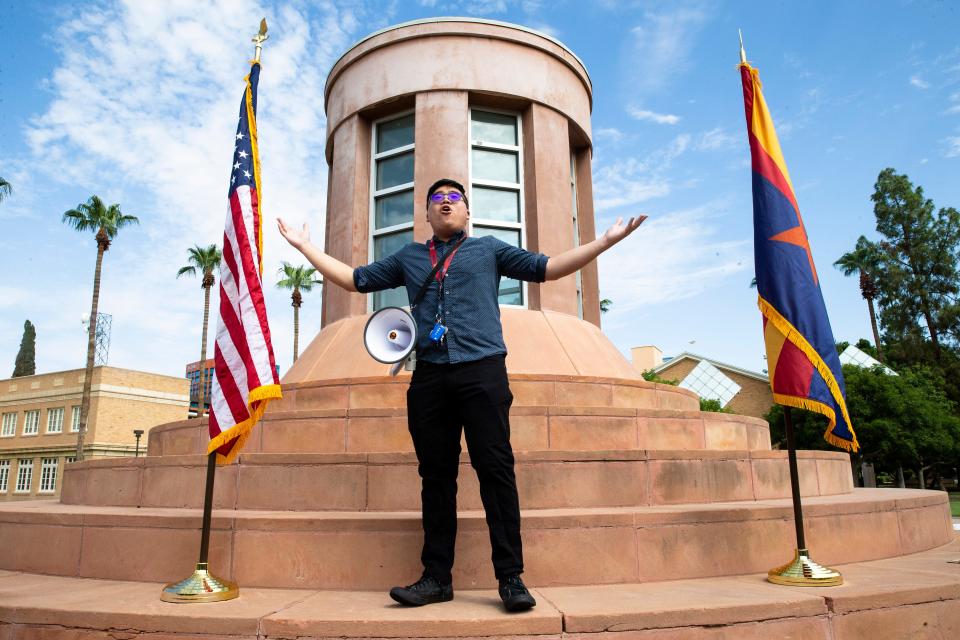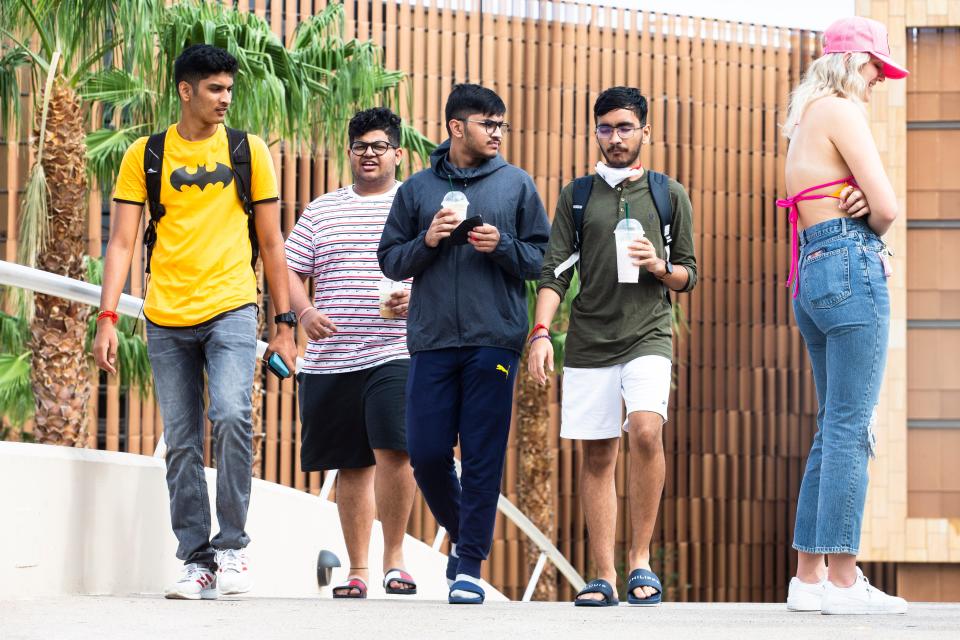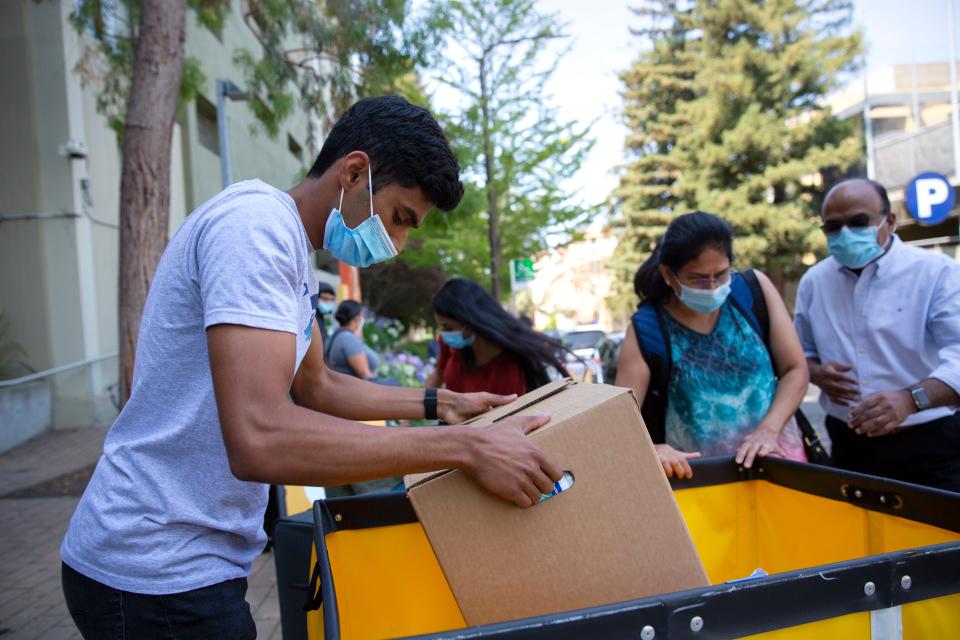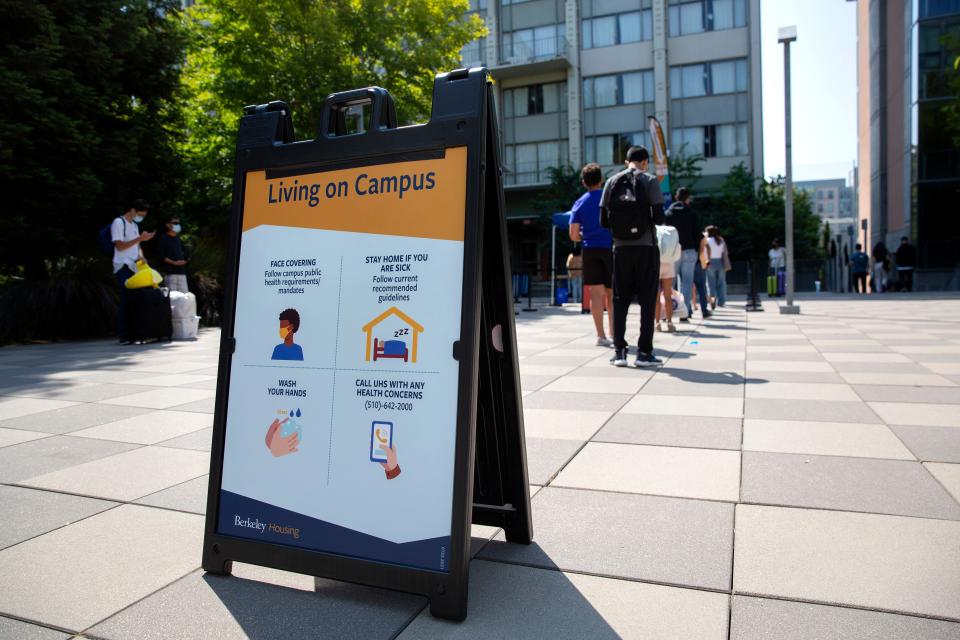Vaccine mandates and COVID testing — or neither? Colleges test the limits of ‘normal’ fall
TEMPE, Ariz. - As families chattered outside in a narrow dormitory hallway, four suitemates at Arizona State University were navigating an awkward situation – thanks to the pandemic.
The first-year students, some of whom had just met in person during last weekend’s move-in, were excited to get back to some “normal” in their educational careers. They’ll be wearing masks in class -- unpleasant in the heavy desert heat, but worth it to be able to meet in lecture halls.
Really, Austin Kennedy said, he and other students just want everyone to get vaccinated, especially because doing so would reduce the chances of classes shifting online again.
But one of the students living in the suite, Owen Eaton, broke some unexpected news: He is not vaccinated.
After a short pause, Eaton explained he’d already had COVID-19 and then skipped the shot at his doctor’s advice. His suitemates didn’t press him on the issue. (The Centers for Disease Control and Prevention generally recommends those with prior COVID-19 infections still get the shot.)
No student is required to be vaccinated at Arizona State. An order from Republican Gov. Doug Ducey doesn’t allow such mandates. As it is, ASU is pushing the bounds of an order from Ducey and requiring masks in some indoor spaces where social distancing isn't possible, such as classrooms.
Still, many students aren’t taking a chance. Dozens of students interviewed by USA TODAY said they got vaccinated simply because they’re sick of online classes.
They’re impersonal, and the technology never seems to work as well as it should. It’s too easy, students said, to get distracted with phones, TVs or video game consoles within easy reach. And many said they learn better when they can hear their instructor in person.
Getting vaccinated, students said, is the main way they can control whether they end up back in front of a computer screen for the semester.
Other universities aren’t taking the chance that students won’t vaccinate. More than 700 are requiring the shot, according to the Chronicle of Higher Education, and an increasing number of colleges are reinstituting regular COVID-19 testing, despite having immunized campuses, due to concerns about breakthrough COVID cases and the spread of the delta variant.
Seven hundred miles from Tempe, at the University of California, Berkeley, the start of the semester could hardly look more different.
Berkeley is requiring COVID-19 vaccinations for all students and staff, and mandating that students who live in campus housing get an on-campus test hours before moving in. Free testing centers dot campus, and students must get tested every 180 days to access buildings. (Across the San Francisco Bay at Stanford, weekly testing will be required even for vaccinated students.)

Masks are mandatory. After move-in last week, students who weren’t vaccinated for religious or medical reasons had to self-sequester for seven days in their room and must test weekly.
At Arizona State, students seem to have accepted the potential chaos of the upcoming school year. Many of their parents have been less accepting. Jay Kennedy, Austin's dad, put it simply.
“Get vaccinated and stop the mask bullshit,” he said.
To mandate, or not
The lack of a vaccine mandate at Arizona State mirrors policies in other states dominated by conservatives. Lawmakers in some red areas even have barred universities from mandating that students receive a coronavirus vaccine to attend in-person classes.
That hasn’t stopped these colleges from trying to push their students to get vaccinated, by offering incentives, stating expectations or outright groveling.
At Arizona State, many students have gotten the shot, if only to protect themselves and their chances for an in-person semester.
Ducey’s executive order, which is set to become state law, prevents public universities from requiring students to get vaccinated and barred them from imposing additional requirements for the unvaccinated, like masking requirements or mandated COVID-19 screening.

Those measures helped colleges to slow and contain the spread of the coronavirus in previous semesters, before vaccines became widely available. Local health experts, faculty and students have repeatedly questioned Ducey’s order and fear it may lead to outbreaks. Even with mask usage in at least some spaces, USA TODAY found last September that counties home to colleges fueled some of the nation’s worst outbreaks – and, of course, the delta variant is more contagious.
The ban on vaccine mandates also makes it difficult for the university to track how many students are inoculated. An ASU spokesperson said more than half of students living on campus have shown proof of vaccination. But about 60% to 65% of new students self-reported they had been vaccinated as of early August. Data released by Maricopa County, which is home to ASU, indicate 45% of residents ages 15 to 24 had received at least one vaccine dose as of last week.
Just before the fall semester, ASU did require mask usage for all – not just unvaccinated individuals – in indoor areas where social distancing was impossible. The university insisted it was following CDC guidance, but others saw it as sidestepping the governor’s order. After ASU’s move, the University of Arizona and Northern Arizona University adopted similar guidance, the legality of which Ducey has questioned.
Some were quick to protest the university’s policy. A gubernatorial candidate led a small mid-August demonstration that attracted about 100 people on this campus of thousands.
But last weekend, as students moved in, the tussle between the state and ASU hadn’t reached the sidewalks and hallways of the university. The majority of parents, students and other passers-by went mask-free outdoors and inside campus buildings.
At the Memorial Union building, groups of new students swiped on their smartphones or packed into lines for fast food from Chick-fil-A or Pei Wei. At the campus bookstore, students and families considered T-shirts, caps and bags while mostly ignoring branded university masks. A small cafe even had masking guidance displayed prominently on its front door. Only the employees wore a mask.
Phoenix native Akul Gupta, 18, wore a mask adorned with a Sun Devil, ASU’s mascot, while walking to a convenience store on campus. He was one of the few on campus last Saturday wearing one, and condensation had gathered around the edge of his glasses in the oppressive heat of the Arizona summer. Still, the young man from the Phoenix area wore it undeterred. Gupta, who is vaccinated, said he would keep wearing a mask if it meant he could return to normal classes.
“It’s just a piece of cloth,” he said.

Dorm-living: ‘A waste’?
At UC Berkeley move-in, lines stretched across the Rec Sports Facility, one of several on-campus COVID-19 testing sites, but moved surprisingly fast. Incoming first-year Divya Chandrasekharan was in and out Wednesday in 30 minutes for her required test. The efficiency impressed her.
Each student received a plastic bag with a test tube and cotton swab. Separated by dividers, instructors walked students through the procedure: Swirl the cotton swab in each nostril 10 times, then swirl it in the test tube 10 times. Dispose of the unnecessary equipment in the biohazard trash, then drop the sample in a designated tray.
One student said it felt like the swab was “touching my soul.”


The one catch: Tests weren’t rapid. Students wouldn’t have results for a few days -- after they’d already interacted with dozens of other dorm residents. In line Wednesday, parents and students grumbled.
“It’s insane,” said Genesis Martinez, 18, a first-year from Los Angeles. “Why couldn’t we just bring proof of a negative test?”
Martinez took her test Monday, one of the first students to move in. She got her (negative) results Wednesday afternoon, and joked that she planned on being the dorm “snoop,” eavesdropping on other students’ conversations to hear if anyone came back positive.
Janet Gilmore, a spokeswoman for Berkeley, said the school was using the slower, more reliable PCR testing because “it is the gold standard.” The school is tracking testing numbers, positive cases and immunization data on its public dashboard.
UC Berkeley’s COVID-19 restrictions are legendary. In the spring, students living in campus housing were briefly banned from going outside, even to exercise. It’s easy to think students would have no fun or freedom, said Christian Gomez, a senior on the men’s soccer team. But Gomez is grateful to be part of a campus that takes COVID seriously. He’s heard stories from other schools where restrictions and mask mandates weren’t enforced, and he couldn’t imagine feeling safe.
“Coming to Cal, I was well aware of how progressive they are,” he said. “That aligned with my values. So when the school encouraged us to be as safe as possible, it’s a no-brainer for me to think that way, too.”
Gomez is willing to comply with all the rules, no matter how strict, if it means students can have some normalcy. “We understand now how fast we can lose everything,” he said.
But “normal” might be a stretch.
Martinez, the first-year from L.A., was comparing class schedules with her roommate Monday when she noticed something surprising: Her sociology lecture was labeled “in the cloud” instead of “in person.” That had been her only in-person course. Her fall 2021 schedule was now composed entirely of online classes.
“It does feel like a waste,” she said. “I’m paying $21,000 to live in a 10-by-10 (foot) dorm facility, and the only in-person instruction I’m getting is a ‘class discussion’ with a max of 17 students?”
Berkeley is keeping all lectures of 200-plus students online for the foreseeable future.
To get an in-person fix, Martinez plans to get involved in extracurricular activities, including student government. Still, she’s worried about variants and leery of big gatherings, even when they’re outdoors. Monday evening, a welcome-to-campus trivia night brought out more than 100 students. Martinez fled to her room as students crowded the space. But even there, she’s concerned.
“The dorms are so packed,” she said. “It kinda gives me the creeps.”


'Normal,' in 2021
Last Saturday, moving crews wearing neon yellow shirts rapidly tried to unpack a seemingly never-ending line of cars carrying families, students and their sundry belongings into the residence halls on Arizona State’s campus. The trick to their speed? Keep the parents in their vehicles, said mover Jesse Young. If they get out, he explained, parents want to micromanage the process.
The cardboard bins rattled along the concrete as the movers hustled through the heat, trying to get students’ belongings to their residences before they arrived. More than 14,350 first-year students are to be living at the university, a record number for the already massive institution.
Savannah Dagupion and her family were part of the thousands that had converged in Arizona for the start of classes. Her mother, Stacy Pang, took in the campus’ clean buildings, noticed space for social distancing and felt confident her daughter would be fine. Although she’d prefer a vaccine mandate, the university seemed to know what it was doing, she said.
Savannah, an 18-year-old first-year from Hawaii, is vaccinated and said she isn’t worried about her safety. She’s used to wearing a mask by now.
Even so, this semester marks a new experiment for higher education. No longer are most colleges hosting reduced in-person offerings. Instead, campuses are flooded with students.
The arrival of vaccines was supposed to herald the start of the “normal” semester, but the delta variant is fueling a surge that already has some institutions on their heels. The University of San Antonio at Texas, for example, plans to hold the first three weeks of its fall semester online in response to a local delta variant surge. Rice University in Houston also pivoted to online courses for two weeks, and had cited a higher than expected rate of infections among vaccinated people. The university later said it suspected false positives drove up its infection rate, but that it would stick with online courses until Sept. 3.
Like in Arizona, Texas’ political leadership has limited what universities can do to mitigate the risk of covid on campus. But universities have started pushing back against these orders, and they’re winning court cases over them.
Indiana University Bloomington, for example, said it would require students to be vaccinated despite a state law that seemed to bar mandates. A move by the U.S. Supreme Court allowed the university’s mandate, which accommodates medical and religious exemptions, to stand. And last week, the South Carolina Supreme Court permitted the University of South Carolina to move ahead with a mask mandate.
At Arizona State, President Michael Crow rolled out the new mask policy as tens of thousands of students arrived on campus. In an interview, he said the university is constantly updating its practices based on factors including the number of students infected on and off campus and overall vaccination rates.

And he denied the university was defying the state government. Rather, he said trying to respond to the pandemic and its variants in real time is like “threading the needle of a moving sewing machine.”
Crow said he was surprised the governor issued an executive order banning vaccine requirements, since Arizona State had never intended to require them. He said he was happy with the university’s original policy, which would have required unvaccinated students to wear masks and submit to regular coronavirus testing. “People should have choice within certain limits,” he said.
As for pivoting to online classes this year, Crow said it was always a possibility, but the prevalence of vaccines reduces those chances.
“We're urging everyone to get vaccinated,” Crow said. “And hopefully they will.”
Even parents are queasy at the possibility of more remote instruction. Kenneth and Erika Dominguez, who both wore masks outdoors, flew their son, Kenneth, to Arizona from Texas for his first year studying health sciences.
It would be like a “dream being shattered” if classes went virtual, the elder Kenneth Dominguez said. So they made sure their son got vaccinated, and implored him to stay on top of other prevention measures like hand-washing.
Safe but fun?
At Berkeley, some students are pushing back on the notion that the campus is a safe haven from the virus.
Vaccine mandate aside, Khodamorad Moradpour, 23, has concerns about his fellow students -- particularly those who are immunocompromised.
Moradpour, a senior, is co-chair of the Disabled Students Commission. He was disheartened to discover Cal wouldn’t offer an online option for students this semester, and that students, even immunocompromised ones, were expected to attend campus in-person. Moradpour lives with, and helps care for, his 60-year-old father in Walnut Creek, about 20 minutes east of Berkeley.
“Do I feel safe?” he said. “No. Because I can attend school and possibly get COVID from who’s sitting next to me -- I don’t know where they’ve been, what they’ve been doing, if they have it and aren’t showing symptoms -- and then give it to my dad, who is high risk, and put his life in danger.”
Schools can impose as many COVID restrictions as they want, but that won’t stop college students from doing what many know best: partying.
On Wednesday night, with rooms assigned and introductions complete, music thumped from one dorm’s courtyard as a mix of masked and unmasked students packed tightly together. As One Direction’s “What Makes You Beautiful” blared from the speakers, students waved their hands back and forth, some sporting glowsticks on their necks and wrists.
A few blocks away on Frat Row, several Greek houses blasted music and flashed lights as students spilled onto the sidewalk and street waiting to get in. Huddled in large and newly formed groups, the crowds were largely unmasked. As the music thumped and students chattered, several shirtless men stood by the entrance of one fraternity slowly letting students in and shouting directions to be patient.
“You don’t need a mask to get in,” said one student as he worked his way through the crowd.
Nearly every student on Frat Row was unmasked. One small group wearing masks remained slightly removed from the masses.
One R.A. observed the nightlife wryly, unsurprised to see unmasked students making merry. Of course everyone was going to party, she said.
But it doesn’t bother her. Because at least here, everyone is vaccinated.
This article originally appeared on USA TODAY: Colleges on COVID testing, vaccine mandate: How to stop delta variant

